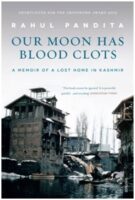Last Updated on September 1, 2021 by themigrationnews

Our Moon Has Blood Clots is a memoir about the lost home in Kashmir by Rahul Pandita, published in 2013. The author narrates the plight of Kashmiri Pandit’s migration to different parts of India in the 1990s. The book is divided into five parts which describe the different phases of the history of Kashmir, but the dominant section deals with the exodus of Kashmiri Pandits. It is a devastating and heart-breaking tale of a powerless minority which lost their homeland and took refuge across the globe. It brings the subaltern and marginalised voice of Kashmiri Pandits into mainstream literature. The violence, trauma, and nostalgia of exile is depicted by the author through his personal struggle. It is full of pain, sufferings, anger, and the struggle for survival.
This memoir is about the life in exile which one experiences after losing his/her home due to war or conflict. The author provides a counter narrative to the well-established cannon of literature where the voice of the Pandits have largely been subjugated or ignored. The whole book is written from the migrant’s perspective, which helps one to understand the complexities of the difficult situations in which the pandits find themselves. Issues like maladjustment, lack of education, unemployment, gamophobia and identity crisis perturbed the migrants and make their situation from bad to worse. Muslims blame the then Governor of Jammu and Kashmir Jag Mohan for the exodus of Pandits because he did not provide them the security in their homeland. Instead, he helped them in moving out by arranging transport facilities. Muslims also consider the Pandits as opportunists for migrating to the safer places leaving the Muslims to suffer. Rahul negates this discourse and brings forth a new perspective of his own community.
In part one, the author puts light on the different periods of Kashmir history. This region had been ruled by multiple dynasties belonging to different religions like Hinduism, Sikhism and Islam. The narrative starts in 1996 when the author was staying in his flat in Delhi and goes back to the peaceful times of Kashmir before 1980s. Everything in the valley was good before the insurgency movement. The different sections of society were living in peaceful coexistence. Rahul vividly depicts the traditions and culture of Kashmir. Festivals like Eid and Shivratri were celebrated by both the communities with great fervour and gaiety. Most of the population were confined in Kashmir only where their lives revolved around their homes. Shalimar Garden, Pari Mahal, Aharbal waterfall and Dal Lake were the spots of their vacations. There used to be small strifesover the India-Pakistan cricket matches between the two communities, but it never turned into communal disharmony or riots.
In the second part, the author reveals the reasons of mass exodus of Kashmiri Pandits in the 1990s. It was during this decade that the rift between Muslims and Hindu started. They looked at each other with suspicious eyes. The insurgent movement of Kashmiri Muslims had put the lives of Pandits in jeopardy who were suspected as collaborators and loyal to Indian army. In order to spread the terror in the whole valley, prominent Pandits like Lasa Kaur, Director Doordarshan and Satish Tickoo, a well-known businessman among many others were killed. Newsreaders were asked to quit their jobs in Radio and Television so that people would not be able know the actual situation. Pandits were ordered to leave the valley, “Advertisements had appeared in some Urdu newspapers. Released by various militant organisations, they asked the Pandits to leave the Valley immediately or face dire consequence” (Pandita 94). Jag Mohan, the then governor of Jammu and Kashmir could not stop the exodus of Pandits to Jammu. Rahul’s family packed whatever little they could into few suitcases and shipped to Jammu. Their sufferings did not end by leaving their homeland. New challenges and hardships engulfed them from all sides. They became worried, “Where were we going to live? Where would the money come from? Was everyone else safe- our friends, relatives”? (Pandita, 100)
Part Three deals with the hardships of the migrants in the refugee camps and other lodgings. Those who took rooms on rent were under constant surveillance of their landlords who continuously used to look how much water they consume, how much electricity they use, what kind of food they cook and who comes to visit them. In the refugee camps, the migrants suffered lack of basic necessities like drinking water and toilet facilities. There was lot of anger and distress among them. Their immovable property in Kashmir was either usurped up the state government or was erased from the official records. Some of them sold their property to meet the financial crisis. Initially the residents of Jammu welcomed them, but gradually they developed antipathy towards Kashmiri Pandits and taunted them with abusive words.
The migrants were living in unhygienic conditions and as a result they developed diseases which were hitherto unknown to them. Their trauma of exile was beyond imagination. Rahul’s father was very much concerned regarding the education of his son, so he had sent him to Chandigarh (India) for higher studies. He also sold his house in Kashmir to treat his ailing wife in a better hospital.
Part Four delineates the grief and misfortune of Kashmiri Pandits during the 1947 tribal raids of Pakistan. The invaders came from the Northwest Frontier Province and – entered Baramulla to make a way to Srinagar. The news of their arrival spread terror in the Hindu community. In order to save their lives, the Pandits fled to unknown destinations without informing anyone. People were killed, houses ransacked to get the gold and other valuable items. Maqbool Sherwani, a member of National Conference misguided the tribesmen so they could never reach Srinagar. He was brutally killed by the Pathans for his loyalty to India. This section helps us to understand how Kashmir became an important issue and why disputes happened between India and Pakistan after Independence.
Part Five brings forth the nostalgia for the past. Kashmir has now became a part of their memory. The new generation did not find much emotional attachment to the land of their ancestors. They are losing their customs and traditions in exile. Rahul’s mother lost her voice and could not walk due to back pain. In order to bring happiness in his parent’s lives Rahul bought a flat in Delhi which is now his home. He worked as a journalist in Kashmir to report the episodes of human violation in the valley. He is hopeful that one day he will be back with his family and community in his homeland.
In conclusion, it can be said that the book is not just the memoir about the personal life of Rahul Pandita but it is a tragic tale of his whole community. It presents before readers the unheard story of the vulnerable people who left their homeland mostly due to religious persecution. The episodes mentioned in the book are true to the history. One loophole in the book which reviewer could find that the author blames the whole Muslim population of the valley for their exodus which can be contradicted with other accounts which were written at that time. It was such a horrible period in the Kashmir history that countless Muslims lost their lives for no genuine reasons. Overall, this is a wonderful book which not only highlights the sufferings of Kashmiri Pandits but also praises their resilience. This book is worth reading for scholars and common readers who want to study forced displacement and to all the people who want to see what it means to lose a home/homeland. It is wakeup call to all the world for mutual understanding and respect for diversity. Rahul is highly concerned about his dispersed community scattered all around, he wishes for their peaceful return to their ancestral land.

Waseem Ahmad is a Researcher at the Aligarh Muslim University. His areas of interest are Migration and the diasporic literature.
